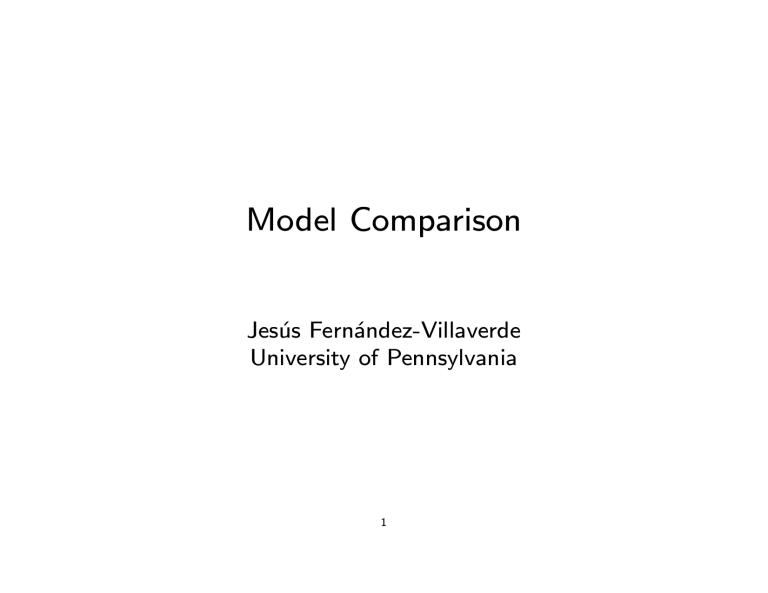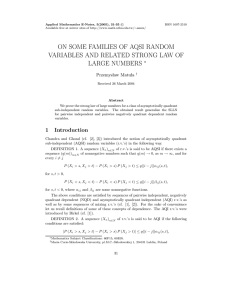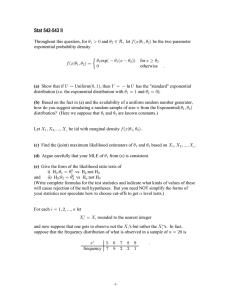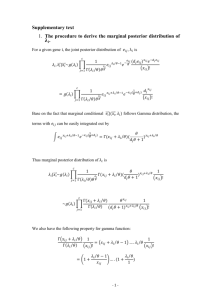Model Comparison Jes´ us Fern´ andez-Villaverde
advertisement

Model Comparison
Jesús Fernández-Villaverde
University of Pennsylvania
1
Model Comparison
• Assume models 1, 2, ..., I to explain Y T . Let M = {1, 2, ..., I}.
• Let {Θ1, Θ2, ..., ΘI } be associated parameter sets.
n
o
T
T
T
f (Y |θ1, 1), f (Y |θ2, 2), ..., f (Y |θI , I) be associated likeli-
• Let
hood functions.
• Let {π (θ1|1) , π (θ2|2) , ..., π (θI |I)} be associated prior distributions.
• Let {π (1) , π (2) , ..., π (I)} be associated prior about the models.
2
Marginal Likelihood and Model Comparison
PI
• Assume i=1 π (i) = 1.
• Then Bayes rule implies posterior probabilities for the models:
³
π i|Y T
³
´
³
π i, Y T
´
π (i) P (Y T |i)
³
´= P
.
=P
k π (i) P (Y T |i)
k π i, Y T
i=1
i=1
´
R
T
where P Y |i = ΘM i f (Y T |θi, i)π (θi|i) dθi
• This probability is the Marginal Likelihood.
3
Why is the Marginal Likelihood a Good Measure to Compare Models?
• Assume i∗ is the true model, then:
³
π i∗|Y T
• Why?
³
π i∗|Y T
´
´
→ 1 as T → ∞.
π (i∗) P (Y T |i∗)
=P
= Pk
T
k
i=1 π (i) P (Y |i)
π (i∗)
P (Y T |i)
i=1 π (i) P (Y T |i∗ )
• Under some regularity conditions, it can shown that:
P (Y T |i)
∗}
→
0
as
T
→
∞
for
all
i
∈
M/
{i
P (Y T |i∗)
4
An Important Point about Priors
• Priors need to be proper. Why?
´
T
• If priors are not proper then P Y |i may not be proper, and it cannot
be interpret as a probability.
³
• If priors are proper and likelihood is bounded, then the Marginal Likelihood exists.
• How do we compute it?
5
Approach I — Drawing from the Prior
• Let
n
oM
θij
be a draw from the prior of model i, π (θi|i).
j=1
³
´
1
• By Monte-Carlo integration: P ∗ Y T |i = M
PM
T
j=1 f (Y |θij , i).
• Very inefficient if likelihood very informative.
h
³
´i
V ar P ∗ Y T |i
M ³
³
´´2
1 X
T
∗
T
'
f (Y |θij , i) − P Y |i
very high.
M j=1
• Likelihood very informative if likelihood and prior far apart.
6
Example I — Drawing from the Prior
• Assume the true likelihood is N (0, 1).
• Let calculate the Marginal Likelihood for different priors.
• N (k, 1) for k = 1, 2, 3, 4, and 5.
7
Example I — Drawing from the Prior
k ³
´
∗
T
P Y |i
¡
¢
V ar[P ∗ Y T |i ]0.5
P ∗(Y T |i)
Marginal Likelihood
1
2
3
4
0.2175 0.1068 0.0308 0.0048
0.6023 1.1129 2.0431 4.0009
8
Example II — Drawing from the Prior
• Assume the likelihood is N (0, 1).
• Let us calculate the Marginal Likelihood for different priors.
• N (0, k) for k = 1, 2, 3, 4, and 5.
9
Example II — Drawing from the Prior
³k
´
∗
T
P Y |i
¡
¢
V ar[P ∗ Y T |i ]0.5
P ∗(Y T |i)
Marginal Likelihood
1
2
3
4
0.2797 0.1731 0.1303 0.0952
0.3971 0.8292 1.1038 1.4166
10
Approach II — Important Sampling
³
´
T
• Assume we want to compute P Y |i .
• Assume ji(θ) is a probability density (not a kernel) which support is
contained in Θi.
³
´
³
´
T
T
• Let P θ|Y , i ∝ f Y |θ, i π (θ|i), both properly normalized den-
sities (not kernels).
³
´
• Let w (θ) = f Y T |θ, i π (θ|i) /ji(θ).
11
Approach I I— Important Sampling
• Let {θij }M
j=1 be a draw from ji (θ). It can be shown that:
∗ =
wM
³ ´
PM
j=1 w θ ij
M
→
³
´
Z f Y T |θ , i π (θ |i)
i
i
ji (θi)
³
´
T
ji (θi) dθi = P Y |i
• If w (θ) is bounded above, then we also have:
σ ∗2 =
³ ´
PM
∗ ]2
[w
θ
−
w
ij
m=1
M
M
12
→ σ2
Approach I I— Important Sampling
• The problem is the common drawback of important sampling.
• To find ji (θ) such that w(θ) is bounded and well-behaved.
• Alternative: use the posterior. How?
13
Approach III — Harmonic Mean
• Argument due to Gelfand and Dey (1994).
• Let fi(θ) be a p.d.f. which support is contained in Θi.
• Then, it can be proved that:
Z
1
fi(θi)
T , i)dθ
³
´
P
(θ
|Y
=
i
i
P (Y T |i)
Θi f Y T |θ i, i π (θ i|i)
14
Proof
Since:
³
´
T
f Y |θi, i π (θi|i)
T
³
´
P (θi|Y , i) = R
T
Θi f Y |θi, i π (θi|i) dθ i
Z
³
fi(θi)
P (θi|Y T , i)dθi =
´
Θi f Y T |θ i, i π (θ i|i)
³
´
T
f Y |θi, i π (θi|i)
fi(θi)
³
´
³
´
dθi =
=
R
T
T
Θi f Y |θ i, i π (θ i|i) Θ f Y |θ i, i π (θ i|i) dθ i
i
R
1
1
Θi fi(θi)dθ i
³
´
³
´
=R
=R
=
T
T
P (Y T |i)
Θi f Y |θ i, i π (θi|i) dθ i
Θi f Y |θi, i π (θi|i) dθ i
Z
15
We Need to Find fi(θ) I
As always, we need to find a fi(θ) such that:
bounded above.
³
fi(θ)
´
T
f Y |θ, i π (θ|i)
16
We need to Find fi(θ) II
• The following proposal is due to Geweke (1998).
• Let {θij }M
j=1 be a draw from the posterior.
• Then we can write:
θiM =
PM
j=1 θij
M
and
ΣiM =
PM
0
j=1(θ ij − θ iM )(θ ij − θ iM )
M
17
We need to find fi(θ) III
• Define now the following set:
2 (k)}
ΘiM = {θ : (θ − θiM )0Σ−1
(θ
−
θ
)
≤
χ
iM
1−p
iM
• Define fi(θ) to be:
0 −1
fi(θ) =
(θ−θiM ) ΣiM (θ−θiM )
(2π)−k/2|ΣiM |−1/2 exp[−
]
2
p
18
ψ ΘiM (θ)
We need to check the two conditions:
• Is fi(θ) a p.d.f?
• Does the support of fi(θ) belong to Θi?
19
Is fi(θ) a p.d.f?
• Remember that f (θi) equals:
0 −1
fi(θ) =
(θ−θiM ) ΣiM (θ−θiM )
(2π)−k/2|ΣiM |−1/2 exp[−
]
2
p
• And, since:
Z
ψ ΘiM (θ) ≥ 0
0Σ−1 (θ − θ
)
(θ
−
θ
iM
iM )
−k/2
−1/2
iM
(2π)
|ΣiM |
exp[−
]=p
2
ΘiM
it does integrates to one.
• Therefore, fi(θ) is a p.d.f
20
Does the Support of fi(θ) Belong to Θi?
• The support of fi(θ) is ΘiM .
• In general we cannot be sure of it.
• If Θi = Rki there is no problem. This is the case of unrestricted
parameters. Example: a VAR.
• If Θi ⊂ Rki , maybe there is a problem. If ΘiM Ã Θi, we need to
redefine the domain of integration to be ΘiM ∩ Θi.
• As a consequence, we also need to find the new normalization constant
for fi(θ). This is the typical case for DSGE models.
21
Recalculating the Constant for f (θi)
• If ΘiM Ã Θi.
• We redefine f (θi) as f ∗(θi) in the following way:
0 Σ−1 (θ−θ
(θ−θ
)
iM
iM )
−k/2
−1/2
iM
(2π)
|Σ
|
exp[−
]
1
iM
∗
2
fi (θ) = ∗
ψ ΘiM ∩Θi (θ)
p
p
• Where p∗ = 1 for the case that ΘiM ⊆ Θi.
22
Recalculating the Constant for f (θi) II
How do we calculate p∗?
1. Fix N and let j = 0 and i = 1.
2. Draw θi from fi(θ) and let i = i + 1.
j
3. If θi ∈ Θi, then j = j + 1 if i < N got to 2, else p∗ = N
and exit.
23
Compute the Marginal Likelihood
• Let
n
oN
θij
be a draw from the posterior of model i, P (θi|Y T , i).
j=1
• Then, we can approximate P (Y T |i) using simple Monte Carlo integration:
N
X
fi(θij )
1
−1
³
´ ³
´
=
N
∗
T
T
P (Y |i)
j=1 f Y |θ ij , i π θ ij |i
• Notice that we have to evaluate fi(θij ) for every draw θij from the
posterior.
24
Algorithm
1. Let j = 1.
2. Evaluate fi(θij ).
3. Evaluate
fi(θij )
f (Y T |θij ,i)π (θij |i)
4. If j ≤ M, set j à j + 1 and go to 2
5. Calculate
fi(θij )
1
−1 PM
=
M
j=1 f (Y T |θij ,i)π (θij |i) .
P ∗(Y T |i)
25
Example
• Imagine you want to compare how a VAR(1) and a VAR(2) explain
log yt and log it.
• Let us define a VAR(p) model.
xt = C +
p
X
A(`)xt−` + εt
`=1
• Where xt = (log yt log it)0, C is a 2 × 1 matrix, A(`) is a 2 × 2
matrix for all `, and εt is iid normally distributed with mean zero and
variance-covariance matrix Σ.
26
Example II
• The likelihood function of a VAR(p) is:
L(xT |Ξ(p)) =
ε0t Σεt
(2π)−T |Σ|−T /2 exp− 2
where Ξ(p) = {C, A(1), . . . , A(p)}.
• (Bounded) Flat and independent priors over all the parameters.
27
Example III - Drawing from the posterior
1. Set p = 1, j = 1 and set Ξ(1)1 equal to the MLE estimate.
2. Generate Ξ(1)∗j+1 = Ξ(1)j + ξ j+1, where ξ j+1 is an iid draw from a
normal distribution with mean zero and variance-covariance matrix Σξ
and generate ν from uniform [0, 1].
L(xT |Ξ(p)∗j+1 )
∗
if α(Ξ(p)∗j+1, Ξ(p)j ) < ν.
3. Evaluate α(Ξ(p)j+1, Ξ(p)j ) =
T
L(x |Ξ(p)j )
Then Ξ(1)j+1 = Ξ(1)∗j+1, otherwise Ξ(1)j+1 = Ξ(1)j .
4. If j ≤ M, set j à j + 1 and go to 2, otherwise exit.
28
Example IV - Evaluating the Marginal Likelihood
• Since priors are flat, the posterior is proportional to the likelihood
L(xT |Ξ(p)) for all p.
• Repeat the algorithm for p = 2.
M be draws from the posterior of the
• Let {Ξ(1)j }M
and
{Ξ(2)
}
j
j=1
j=1
VAR(1) and VAR(2) respectively.
29
Example V - Evaluating the Marginal Likelihood
Calculate:
Ξ(p)M =
and
Σ(p)M =
PM
j=1 Ξ(p)j
M
PM
0
j=1(Ξ(p)j − Ξ(p)M )(Ξ(p)j − Ξ(p)M )
M
for p = 1 and p = 2.
30
Example VI - Evaluating the Marginal Likelihood
• Calculate {fi(Ξ(p)j )}M
j=1 for p = 1 and p = 2.
• Calculate:
M
X
fi(Ξ(p)j )
1
−1
³
´
=
M
∗
T
T
P (x |p)
j=1 L x |Ξ(p)j
31
A Problem Evaluating the Marginal Likelihood
³
• Sometimes, L xT |Ξ(p)j
´
is a to BIG number.
• For example: The log likelihood of the VAR(1) evaluated at the MLE
equals 1, 625.23. This means that the likelihood equals exp1,625.23. In
Matlab, exp1,625.23 = Inf .
• This implies that:
M
X
fi(Ξ(p)j )
1
−1
³
´ =0
=
M
∗
T
T
P (x |p)
j=1 L x |Ξ(p)j
32
Solving the Problem
• In general, we want to compute
M
X
fi(θij )
1
−1
³
´ ³
´
=M
∗
T
T
P (Y |i)
j=1 f Y |θij , i π θ ij |i
³
´
³
´
³
´
T
T
• Instead of evaluating f Y |θij , i and π θij |i , we evaluate log f Y |θij , i
³
´
and log π θij |i for all {θij }M
j=1 and for each of the models i.
³
´
³
´
T
• For each i, we compute ℘i = maxj {log f Y |θij , i + log π θij |i }.
• Then, we compute ℘ = maxi{℘i}.
33
• Compute:
³
´
³
´
³
´
T
T
e
log f Y |θij , i = log f Y |θij , i + log π θij |i − ℘.
• Compute
³
´
³
´
T
T
e
e
f Y |θij , i = exp log f Y |θij , i .
• Finally, compute
M
X
fi(θij )
1
−1
³
´
=
M
e
T
e
T
P (Y |i)
j=1 f Y |θ ij , i
• And note that
log Pe (Y T |i) − log Pe (Y T |s) = log P ∗(Y T |i) − log P ∗(Y T |s)
34
• Why?
• Note that
M
M
X
X
f
(θ
)
fi(θij )
1
i
ij
−1
−1
³
´
¡
¢
=M
=M
T
e
T
e
T
f Y |θij ,i π (θij |i)
P (Y |i)
j=1 f Y |θ ij , i
j=1
℘
• Therefore
℘
1
=
P ∗(Y T |i)
Pe (Y T |i)
35







